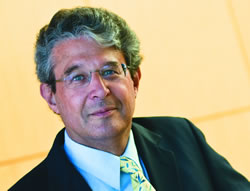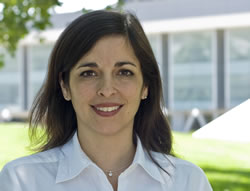

Brandon Patterson presents his team's project to a group of mentors and fellow students.
The U’s International Leadership Academy is bringing the international community closer to campus.
By Brett Hullinger
On a brilliant, late spring day, with the semester winding down and the halls of the Olpin Union otherwise quiet, a phalanx of Utah’s preeminent movers and shakers is filing into a third-floor conference room. Among them are the president and CEO of World Trade Center Utah, the VP of international finance for Zions Bank, and one of Gov. Jon Huntsman’s key economic advisors. You couldn’t throw a Rolodex without hitting a venture capitalist, government official, or corporate titan. And any one of them could command the podium.
But not today. Today, they are the audience, and 20 undergraduates have the stage. The students are part of the U’s nascent International Leadership Academy (ILA), a unique program in which each student is assigned a mentor—someone from the community engaged in international affairs within government, business, or a nonprofit organization.
As the mentors take their seats, the students, working in teams of three, begin reporting on their international leadership projects. Whether it’s sending prescription eyeglasses to the disadvantaged in Bolivia, or making microfinance loans to budding entrepreneurs in Nigeria, each project is creating tangible, positive change in our world.
Associate Professor of Political Science Howard Lehman, an affiliated faculty member of the Honors College, and Anjali Pai Hallett MEd'09, associate director for International Programs and Services at the U’s International Center, sit in the front row, observing the proceedings like proud parents. Together they spearheaded the creation of the ILA. The impetus for the semester-long course—elevated to the level of an “academy” as a way of emphasizing its uniqueness—came from Hallett. In 2005, she attended a conference at Texas A&M, where officials highlighted the success of their own pioneering Academy for Future International Leaders.
“At the time,” says Hallett, “the U was just beginning to internationalize, and they were looking for courses to fulfill the international requirement.” (As of 2007, the U requires all undergraduates to complete an internationally themed class—part of President Michael K. Young’s emphasis on internationalism in education.) “And this was such a unique idea because it wasn’t just a course; it also included bringing people in from the community and a mentoring component. So I thought, Why can’t we do that at the U?”
It turned out to be an easy sell. University officials came on board quickly, a fact that Hallett attributes largely to the ILA’s mentoring aspect. “I think it just speaks to people,” she says, adding that the U had no shortage of volunteers from the community who wanted to have a deeper connection to campus through students. The mentorship provided that conduit.
Soon enough, the ILA had the green light; now all it needed was an instructor.

Associate Professor of Political Science Howard Lehman
Howard Lehman first became interested in international affairs while backpacking in Africa in the late 1970s. Nearly 30 years later—22 of them spent as a political science professor at the U—his interest has not waned. Lehman jumped at the chance to head up the ILA.
“I thought it would be kind of fun for undergraduates to tie in things global, but relating them to Utah,” he says. “One of the objectives of the program is to teach students that living and working in Utah doesn’t mean you are in an isolated place. There are a lot of international connections here.”
Using the Texas A&M program as a model—with that school’s encouragement and assistance—Lehman and Hallett began laying out the structure of the U’s program. Lehman was clear that he wanted the ILA to be more than just a course. By framing it as an academy, he hoped to foster a sense of something larger, a place where students would interact with each other and the community in ways that go beyond the strictures of a typical class.
One of the objectives of the program is to teach students that living and working in Utah doesn't mean you are in an isolated place. There are a lot of international connections here.
Lehman designed the program with three primary components: a leadership seminar, featuring a series of interactive lectures with prominent local leaders; the mentoring program; and an optional international experience, such as study abroad. In addition, students are required to design and implement an international leadership project within the semester, with the added complication of making it sustainable such that it will continue beyond their own graduation.
The course had immediate appeal for student Tori Ballif BA’09, who signed up for its inaugural semester in Spring 2008. Ballif, who received a degree in history and is now attending Stanford Law School, had always considered herself a take-charge person, but not necessarily a leader. “So that was really interesting to me,” she says, “the concept of, Can you teach leadership? Can you train people to be leaders, or are you already a leader?”
Many of those questions are addressed by the guest speakers who participate as part of the ILA’s seminar component. The lectures opened Ballif’s eyes to the complexity of leadership, such as the need to balance national security while fostering good international relations. “I learned that you don’t have to be right on everything, but you do need to try to consider as many things as possible.”
Ballif also saw firsthand the value of having a mentor to provide guidance. During her ILA semester, she took a two-week trip to India and was shocked at the extreme poverty and social injustice she saw there. Her mentor, Patrick Poulin of the International Rescue Committee, helped her make sense of it. “He talked a lot about his time in Africa with the Peace Corps,” says Ballif. “It was really valuable to have his guidance through that time. He really helped me get past the guilt and shock and on to problem-solving and critical thinking.”
In order to make moments like those possible, Lehman spends considerable time matching mentors and mentees. He has each student fill out a survey that highlights his or her interests, career objectives, and international experience. Once paired, the student and mentor meet for the first time at a luncheon held early in the semester.
Mark Clifton, an international business major in the 2009 ILA, remembers that initial meeting with his mentor, Mark Garfield, the aforementioned Zions Bank executive. “I was kind of nervous,” he admits. “I didn’t know what to expect. But he was really friendly.”
Students are often intimidated about the mentorship at first, says Lehman. They worry about whether they will get along, or if the mentor will be too busy for them. “But what I have found is that the mentors are a unique group of people,” says Lehman. “They are busy, but they really want to be engaged with the University. They often talk about giving back to the U. The other thing is, I think they just really enjoy interacting with students.”

Anjali Pai Hallett, associate director for International Programs and Services at the U’s International Center
Both mentor and student sign a contract that spells out what is expected of each participant. There is even an opt-out clause if there is an unworkable personality conflict. “That has never happened,” assures Lehman. “Both the mentors and the students seem to really enjoy their time together. And they both learn something from it.”
Over the course of the semester, mentors and students meet at least three times, and most maintain ongoing telephone and e-mail contact. Oftentimes the student “shadows” the mentor at work, or accompanies him or her to various functions.
“I got to go to conferences and meetings,” says Clifton. “I met the ambassadors from Egypt and South Africa. I heard them talk about their relations with Utah and different business arrangements. That is simple, practical knowledge that you just don’t get in a classroom.”
Mark Garfield is quick to point out that the experience is equally beneficial to mentors. “It’s fun to be with these students, to see their energy and enthusiasm,” he says. “They are very eager to know about the practical application of international leadership opportunities. It’s refreshing to see these bright kids who want to make an impact and have some influence.”
That impact is on display in the Union Building as the students continue with their presentations. There are occasional (and unintentional) comic elements, such as the overzealous use of a jittery laser pointer and PowerPoint slides crammed with Homeric volumes of text. But it is hard not to be impressed. Whatever is lost in the fine print of a PowerPoint slide is made moot by the fact that eyeglasses are being sent to Bolivia, and refugees are being helped here in Utah. Those results underscore what Garfield describes as one of the biggest rewards of being a mentor in the ILA: “Meeting some of the students in this program,” he says, “I get a general optimism about the future.”
As students and mentors file out of the conference room, a basket on a table by the door coaxes a few more dollars for the microfinance project. The money sitting there in the basket in the U’s Student Center will soon find its way to a seamstress in Peru or a baker in Nigeria. And one can’t help but feel optimistic about the future of our global community.
—Brett Hullinger is a freelance writer living in Salt Lake City.
Return to Fall 2009 table of contents | Back to top
|



